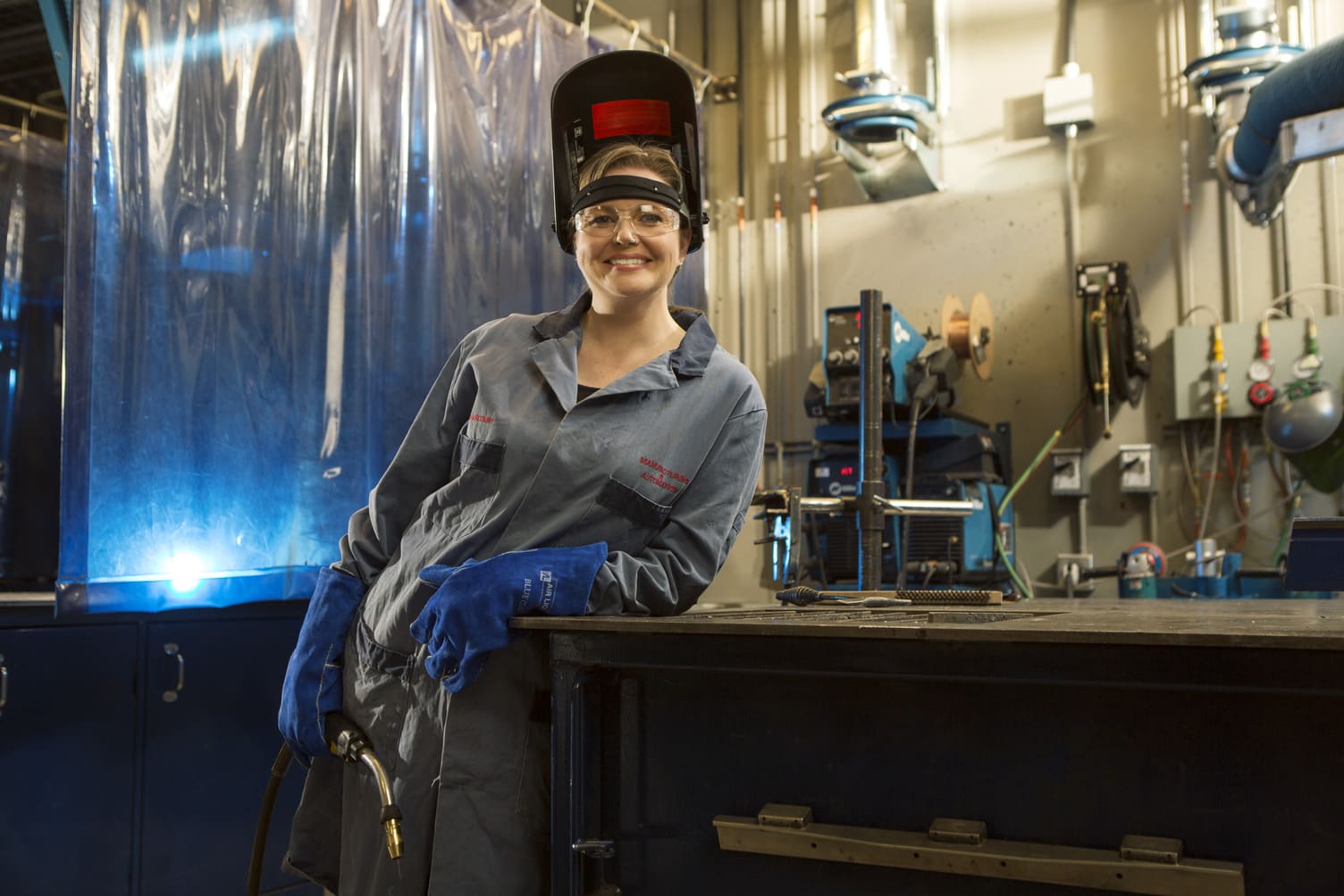On this page:
Overview
Learn to service and operate the hoist and swing equipment used to move machinery, materials and other large objects.
If you like to work independently and are a capable decision-maker, you'll enjoy a career as a mobile crane operator. You'll service and operate booms that are mounted on crawlers or wheeled frames as well as travelling, fixed or climbing-type hoisting equipment with a vertical mast or tower and a jib.
You'll manipulate a number of pedals and levers to rotate the crane and raise and lower its boom and one or more load lines. Some or all of these operations may be performed simultaneously.
Certification is required when operating mobile cranes with a lifting capacity of 13 tons (13.6 tonnes) and over. You may drive the crane to the job site, rig the machine up (pin the boom and pendant cables and pull the hoist cable in preparation for operation), and set up the machine for the lift (make it level and stable) using blocking and levelling materials.
To work in this trade, certification is required. This means that you must either be a registered apprentice who is working under the guidance of a certified journeyperson or you must be a certified journeyperson yourself.
Mobile crane operators are skilled tradespeople who are self-motivated and enjoy working independently.
To succeed in this trade, you should:
- be coordinated and have manual dexterity
- be comfortable working at heights
- have the strength, stamina and ability to use proper lifting techniques
- have good vision
- be able to work as part of a team and communicate with ground crews using hand signals and voice communication
- be committed to maintaining safe work habits.
Upon successfully completing the required working hours and technical training periods, you'll be awarded a certificate in addition to journeyperson status by Alberta’s Apprenticeship and Industry Training.
This is a Red Seal Endorsed trade – a recognizable standard that allows tradespeople to work across Canada.
Careers and opportunities
Our graduates may work in the following occupations. Some careers require additional experience and education.
Associated National Occupational Classification (NOC) codes: 14400, 14405, 70020, 72024, 72500, 73400, 75110.
Apprenticeship training
The term of apprenticeship for a mobile crane operator is three years (three 12-month periods), including a minimum of 1620 hours of on-the-job training and six weeks of classroom instruction in the first year, a minimum of 1800 hours of on-the-job training in the second year and 1620 hours of on-the-job training and six weeks of classroom instruction in the third year.
Year 1 | Period 1
You'll learn about workplace safety, materials and tools. You'll also cover an introduction to boom trucks and cranes, codes and documentation, rigging equipment and procedures, load chart reading and interpretation, equipment operations as well as specialty lifts and workplace coaching.
Training length: 6 weeks
Year 3 | Period 3
You'll learn lattice boom cranes, crane attachments and crane assembly, advanced rigging, advanced lift planning and operations, load charts, lifting operations and Red Seal standards.
Training length: 6 weeks
Apprenticeship education performance
You must pass each section of the course and the AIT exam to succeed in apprenticeship education.
The passing grade for each period is no less than 50% in each course, with no less than a 65% average overall. A passing mark on each provincial exam and the interprovincial qualification (Red Seal Exam) is 70%.
View Alberta's Apprenticeship and Industry Training procedures
Training pathways
You can earn your journeyperson designation in the following way.
The traditional training pathway begins with finding a job with an employer willing to indenture you as an apprentice. Once you are an apprentice, you will alternate between on-the-job training and educational periods.
You must apply for an apprenticeship through Alberta Apprenticeship and Industry Training before attending your first education period at SAIT.
Admission requirements
To enter an apprenticeship, you must have the educational qualifications required or recommended education for the trade to which you apply.
Entrance requirements are monitored and set by Alberta Apprenticeship and Industry Training.
Minimum requirements
Successful completion of the following courses:
- English 10-2
- Math 10-3
OR
A pass mark in all five Canadian General Educational Development (GED) tests
OR
Alberta Apprenticeship and Industry Training entrance exam.
Recommended requirements
Apprentices with an Alberta High School Diploma that includes the following courses:
- English 30-2
- Math 30-3
- Physics 20 OR Chemistry 20 OR Science 20
- Related career and technology studies (CTS) courses

MyTradeSecrets
Once you have begun working as an apprentice, you can attend SAIT to complete your technical training.
You'll register for technical training at SAIT on MyTradeSecrets or you can register by phone.
Transfer agreements
At SAIT, we evaluate post-secondary credit you have previously earned and apply it to your SAIT credential. Explore our formal transfer agreements available for this program.
We can evaluate your prior education, even if we don't have a formal agreement in place.
Submit a transfer credit application
There are no formal transfer agreements currently in place for this program.
Transfer options for graduates
Build on the knowledge you’ve learned at SAIT. The opportunity to advance your education at an accredited post-secondary institution may be available.
🔗 Visit Transfer Alberta search tool for all transfer agreements in Alberta (including UCalgary, MRU and BVC).
If there are transfer agreements with other institutions outside of Alberta, nationally or internationally, they will be listed below.
Thompson Rivers University
- Program name
- Crane and Hoisting Equipment Operator - Mobile Crane
- Available credits:
- 27
Thompson Rivers University
- Program name
- Bachelor of Technology: Trades and Technology Leadership
- Available credits:
- 30
Available intakes
Costs
2024/25 tuition and fees
The following costs are effective as of July 1, 2024.
This is a bring-your-own-device program with a standard computer hardware and software requirement. See the specific requirements on our computers and laptops page.
Books, modules, and PPE are approximately $450 for the first period and $550 for the third period.
Books and learning references for this program can be purchased on the first day of class at our Point Trotter campus.

Funding options for apprentices
Apprentices get to learn while they earn, but there are still costs to consider. Many resources are available at SAIT and federally to help support apprentices.
Information sessions
Prepare for a strong start in your chosen program or get the details you need to decide your future path.
Our expert staff and faculty are ready to answer your questions and provide information about the following:
- What sets SAIT apart
- An introduction to the program and area of study
- Admission requirements
- Future career paths
- Information on the earning potential and graduate employment rates.
Contact
Have more questions?
Apprenticeship training and registration
Apprenticeship and Industry Training Client Services

Oki, Âba wathtech, Danit'ada, Tawnshi, Hello.
SAIT is located on the traditional territories of the Niitsitapi (Blackfoot) and the people of Treaty 7 which includes the Siksika, the Piikani, the Kainai, the Tsuut’ina and the Îyârhe Nakoda of Bearspaw, Chiniki and Goodstoney.
We are situated in an area the Blackfoot tribes traditionally called Moh’kinsstis, where the Bow River meets the Elbow River. We now call it the city of Calgary, which is also home to the Métis Nation of Alberta.
